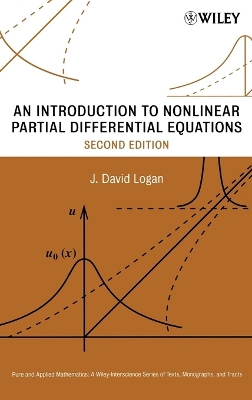Pure and Applied Mathematics: A Wiley Series of Texts, Monographs and Tracts
1 primary work • 2 total works
Book 89
An Introduction to Nonlinear Partial Differential Equations 2e
by J. David Logan
Published 6 April 1994
Praise for the First Edition: "This book is well conceived and well written. The author has succeeded in producing a text on nonlinear PDEs that is not only quite readable but also accessible to students from diverse backgrounds." -SIAM Review A practical introduction to nonlinear PDEs and their real-world applications Now in a Second Edition, this popular book on nonlinear partial differential equations (PDEs) contains expanded coverage on the central topics of applied mathematics in an elementary, highly readable format and is accessible to students and researchers in the field of pure and applied mathematics. This book provides a new focus on the increasing use of mathematical applications in the life sciences, while also addressing key topics such as linear PDEs, first-order nonlinear PDEs, classical and weak solutions, shocks, hyperbolic systems, nonlinear diffusion, and elliptic equations.
Unlike comparable books that typically only use formal proofs and theory to demonstrate results, An Introduction to Nonlinear Partial Differential Equations, Second Edition takes a more practical approach to nonlinear PDEs by emphasizing how the results are used, why they are important, and how they are applied to real problems. The intertwining relationship between mathematics and physical phenomena is discovered using detailed examples of applications across various areas such as biology, combustion, traffic flow, heat transfer, fluid mechanics, quantum mechanics, and the chemical reactor theory.
New features of the Second Edition also include: Additional intermediate-level exercises that facilitate the development of advanced problem-solving skills New applications in the biological sciences, including age-structure, pattern formation, and the propagation of diseases An expanded bibliography that facilitates further investigation into specialized topics With individual, self-contained chapters and a broad scope of coverage that offers instructors the flexibility to design courses to meet specific objectives, An Introduction to Nonlinear Partial Differential Equations, Second Edition is an ideal text for applied mathematics courses at the upper-undergraduate and graduate levels. It also serves as a valuable resource for researchers and professionals in the fields of mathematics, biology, engineering, and physics who would like to further their knowledge of PDEs.
Unlike comparable books that typically only use formal proofs and theory to demonstrate results, An Introduction to Nonlinear Partial Differential Equations, Second Edition takes a more practical approach to nonlinear PDEs by emphasizing how the results are used, why they are important, and how they are applied to real problems. The intertwining relationship between mathematics and physical phenomena is discovered using detailed examples of applications across various areas such as biology, combustion, traffic flow, heat transfer, fluid mechanics, quantum mechanics, and the chemical reactor theory.
New features of the Second Edition also include: Additional intermediate-level exercises that facilitate the development of advanced problem-solving skills New applications in the biological sciences, including age-structure, pattern formation, and the propagation of diseases An expanded bibliography that facilitates further investigation into specialized topics With individual, self-contained chapters and a broad scope of coverage that offers instructors the flexibility to design courses to meet specific objectives, An Introduction to Nonlinear Partial Differential Equations, Second Edition is an ideal text for applied mathematics courses at the upper-undergraduate and graduate levels. It also serves as a valuable resource for researchers and professionals in the fields of mathematics, biology, engineering, and physics who would like to further their knowledge of PDEs.
Mathematical Methods in Biology
by J. David Logan and William Wolesensky
Published 11 September 2009
The last several years has witnessed a revolution in the connections between mathematics and biology, and this book differs from most others on the topic in that it covers both deterministic and probabilistic models. The first chapter is a long introduction and review of ideas about biological modeling, calculus, differential equations, dimensionless variables, and descriptive statistics. The next three chapters examine standard discrete and continuous models using difference and differential equations, and matrix algebra (there is a long appendix in Chapter 3 on matrices). The final three chapters cover probability, statistics, and stochastic processes, including bootstrap methods and stochastic differential equations. The book focuses mostly in one area of the life sciences, namely, theoretical ecology. Ecology has become extremely quantitative, and the mathematical techniques used in ecology are applicable to most other areas in the life sciences. Ecology provides an especially accessible context for study by mathematics majors. Moreover, the authors chose ecology for the book's motivations and examples in light of their own interests and research in the area. Additional topical coverage includes an introduction to ecological modeling, population dynamics for single species, structure and interacting populations, interactions in continuous time, concepts of probability, statistical inference, and stochastic processes.

